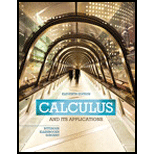
Concept explainers
Let R be the area between
a. Find the volumes of the solids generated by rotating R, with
b. Find the volumes of the solids generated by rotating R, with
c. Find the value of a for which the two solids of revolution have the same volume.
Want to see the full answer?
Check out a sample textbook solution
Chapter 5 Solutions
Calculus and Its Applications (11th Edition)
Additional Math Textbook Solutions
Calculus, Single Variable: Early Transcendentals (3rd Edition)
Precalculus: Concepts Through Functions, A Unit Circle Approach to Trigonometry (4th Edition)
Single Variable Calculus: Early Transcendentals (2nd Edition) - Standalone book
University Calculus: Early Transcendentals (3rd Edition)
Thomas' Calculus: Early Transcendentals (14th Edition)
- Find the exact volume of the solid that results when the region bounded in quadrant I by the axes and the lines x=9 and y=5 revolved about the a x-axis b y-axisarrow_forwardFind the exact volume of the solid that results when the triangular region with vertices at 0, 0, 6, 0 and 6, 4 is rotated about the a x-axis b y-axisarrow_forwardFind the exact volume of the solid that results when the rectangular region with vertices at 0, 0, 6, 0, 6, 4 and 0, 4 is revolved about the a x-axis b y-axisarrow_forward
- For the accompanying right circular cone, h=6 m and r=4 m. Find the exact and approximate a lateral area. b total area. c volume.arrow_forwardFind the volume of the solid of revolution that results when a right triangle with legs of lengths 5 in. and 7in. is rotated about the 7in.leg. Use 227.arrow_forwardFind the exact lateral area of each solid in Exercise 40. Find the exact volume of the solid formed when the region bounded in Quadrant I by the axes and the lines x = 9 and y = 5 is revolved about the a) x-axis b) y-axisarrow_forward
- For a right circular cone, the dimensions are r=6 cm and h=8 cm. If the length of the radius is doubled while the height is made half as large in forming a new cone, will the volumes of the two cones be equal?arrow_forwardFor the right triangular prism, suppose that the sides of the triangular base measure 4 m, 5 m, and 6 m. The altitude is 7 m. a Find the lateral area of the prism. b Find the total area of the prism. c Find the volume of the prism.arrow_forwardFor the sphers x-12+y+22+z-42=36 and x2+y2+z2=64, find the ratio of their a surface areas. b volumes.arrow_forward
- Find the volume of the oblique circular cylinder. The axis meets the plane of the base to form a 45 angle.arrow_forwardFor the right triangular prism found in Exercise 16, suppose that the sides of the triangular base measures 3 ft, 4 ft, and 5 ft. The altitude is 6 ft in length. a Find the lateral area of the prism. b Find the total area of the prism. c Find the volume area of the prism.arrow_forwardThe radius length of the base of a right circular cylinder is 6 in. The height of the cylinder is 10 in. Find the exact a Lateral area b total area c volume.arrow_forward
 Holt Mcdougal Larson Pre-algebra: Student Edition...AlgebraISBN:9780547587776Author:HOLT MCDOUGALPublisher:HOLT MCDOUGAL
Holt Mcdougal Larson Pre-algebra: Student Edition...AlgebraISBN:9780547587776Author:HOLT MCDOUGALPublisher:HOLT MCDOUGAL Elementary Geometry For College Students, 7eGeometryISBN:9781337614085Author:Alexander, Daniel C.; Koeberlein, Geralyn M.Publisher:Cengage,
Elementary Geometry For College Students, 7eGeometryISBN:9781337614085Author:Alexander, Daniel C.; Koeberlein, Geralyn M.Publisher:Cengage, Elementary Geometry for College StudentsGeometryISBN:9781285195698Author:Daniel C. Alexander, Geralyn M. KoeberleinPublisher:Cengage Learning
Elementary Geometry for College StudentsGeometryISBN:9781285195698Author:Daniel C. Alexander, Geralyn M. KoeberleinPublisher:Cengage Learning Linear Algebra: A Modern IntroductionAlgebraISBN:9781285463247Author:David PoolePublisher:Cengage Learning
Linear Algebra: A Modern IntroductionAlgebraISBN:9781285463247Author:David PoolePublisher:Cengage Learning Mathematics For Machine TechnologyAdvanced MathISBN:9781337798310Author:Peterson, John.Publisher:Cengage Learning,
Mathematics For Machine TechnologyAdvanced MathISBN:9781337798310Author:Peterson, John.Publisher:Cengage Learning, Trigonometry (MindTap Course List)TrigonometryISBN:9781305652224Author:Charles P. McKeague, Mark D. TurnerPublisher:Cengage Learning
Trigonometry (MindTap Course List)TrigonometryISBN:9781305652224Author:Charles P. McKeague, Mark D. TurnerPublisher:Cengage Learning





